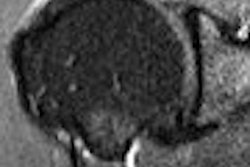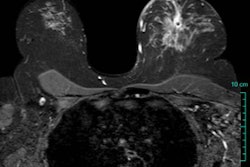German researchers believe they have found a qualitative correlation between nephrogenic systemic fibrosis (NSF)-like symptoms and the release of free gadolinium in an experimental study. In this animal model, a multiple-injection scheme was used to replicate the prolonged systemic exposure to contrast media that is experienced after repeated gadolinium administration in patients with severe renal impairment.
"This pioneering study aims to elucidate the role of unchelated (gadolinium [Gd]) in NSF and to test the hypothesis that the depletion of endogenous ions can have a causative role in NSF," wrote Martin Sieber, Ph.D., and colleagues from Bayer Schering Pharma and the Institute for Veterinary Pathology, both in Berlin. This study was supported by Bayer Schering Pharma (Investigative Radiology, January 2008, Vol. 43:1, pp. 65-75).
The experiment tested the following compounds:
- Gadodiamide with caldiamide (Omniscan, GE Healthcare, Chalfont St. Giles, U.K.)
- Gadodiamide without caldiamide (altered version of Omniscan)
- Gadopentetate dimeglumine (Magnevist, Bayer Schering Pharma)
- Gd-ethylenediamide tetraacetic acid (Gd-EDTA)
Caldiamide is the excess ligand in Omniscan, the group explained, while Gd-EDTA was used as a positive control because it is known to release Gd3+ ions in the body. "It has been speculated that Gd-containing contrast agents may elicit their toxic effects by a direct loss of the Gd3+ ion or through transmetalation -- the exchange of Gd3+ with endogenous ions," the group wrote.
Thirty-five healthy male rats were randomly allocated to one of six treatment groups and dosed with gadopentetate dimeglumine, gadodiamide, or gadodiamide without caldiamide, all at a concentration of 0.5 mol/L. The compounds were injected at a dose of 2.5 mmol Gd/kg, five times a week over a four-week period. Two treatment groups also received intravenous caldiamide and Gd-EDTA. The animals were killed after five days to ensure that the Gd compounds were completely eliminated from the body.
The analysis included macroscopic skin histology, immunohistochemistry, Gd measurements, transmission electron microscopy (TEM), and energy dispersive x-ray (EDX). Gd measurements were taken for the skin, femur, and liver and evaluated with a nonparametric Kruskal-Wallis test.
According to the results, animals injected with Gd-EDTA, gadodiamide, and gadodiamide without caldiamide had skin reddening, fur loss, scab formation, and ulceration. Minimal to moderate increases in cellularity as well as fibrosis in the dermis were noted in animals given Gd-EDTA, gadodiamide, and gadodiamide without caldiamide. However, these changes did not occur in those given gadopentetate dimeglumine or caldiamide. These findings resembled NSF findings seen in humans, the authors noted.
In addition, CD34 fibroblasts in the superficial dermis were evident in the gadodiamide group. In animals treated with 10 injections of gadodiamide, the concentration of Gd in the skin was 2.2 ± 0.2 µmol/g. In the liver, high Gd concentrations were observed at 2.5 ± 0.2 µmol/g in rats given Gd-EDTA. In those given gadodiamide without caldiamide, the concentration was higher at 2.9 ± 0.2 µmol/g. In the femur, those given gadodiamide had a Gd concentration of 0.6 ± 0.1 µmol/g while those injected with gadopentetate dimeglumine had a Gd level of 0.2 ± 0.1 µmol/g.
In one animal with severe skin lesions, TEM showed dark, electron-dense deposits, while the EDX spectrum of those deposits showed two characteristic peaks for Gd. This animal had been given gadodiamide.
"Using (our) model, we observed, in rats, macroscopic lesions, microscopic changes, and histopathologic alterations correlating highly to findings in human NSF patients," the group wrote. "In this study, (gadodiamide) caused severe, macroscopic, NSF-like skin lesions in some animals, whereas (gadodiamide pentetate) did not."
The differences in these two compounds are their respective thermodynamic and conditional stability, as well as the amount of excess ligand. "The higher amount of excess ligand in (gadodiamide) has been introduced to compensate for the lower thermodynamic stability," the authors wrote.
However, based on their results, they stated that the mere presence of the excess ligand was unlikely to be responsible for the skin lesions because the use of caldiamide alone did not lead to NSF-like symptoms. Instead, "the occurrence of the NSF-like lesions seems to be correlated to the stability of the Gd chelates and, thus, to the dissociation of the respective Gd complexes. This dissociation of the Gd complex could generate toxic effects," they wrote.
The authors stated that they are conducting a follow-up investigation of the NSF and gadolinium link by taking a closer look at the differences between marketed gadolinium-based contrast agents.
In an e-mail commentary to AuntMinnie.com, Dr. Albert Morris Jr., the immediate past president of the Washington, DC-based National Medical Association, pointed out that "the challenges associated with extrapolation of animal studies to human subjects is at best unpredictable, and the dose levels used in the study to simulate chronic renal disease were extremely high and repeated over a two-week period. As a diagnostic radiologist that has experience with these agents, it is unclear that the parallels that were drawn from this study only implicate the toxic effects of free gadolinium ions." Click here to read his full comments on this study by Sieber's group.
By Shalmali Pal
AuntMinnie.com staff writer
January 9, 2008
Related Reading
Transglutaminases seen as 'missing link' in nephrogenic systemic fibrosis, October 18, 2007
MR experts take issue with FDA gadolinium warning, September 18, 2007
Noncontrast MR: The solution to the NSF problem? July 26, 2007
FDA asks for 'black box' warning for gadolinium contrast, May 23, 2007
Copyright © 2008 AuntMinnie.com



















